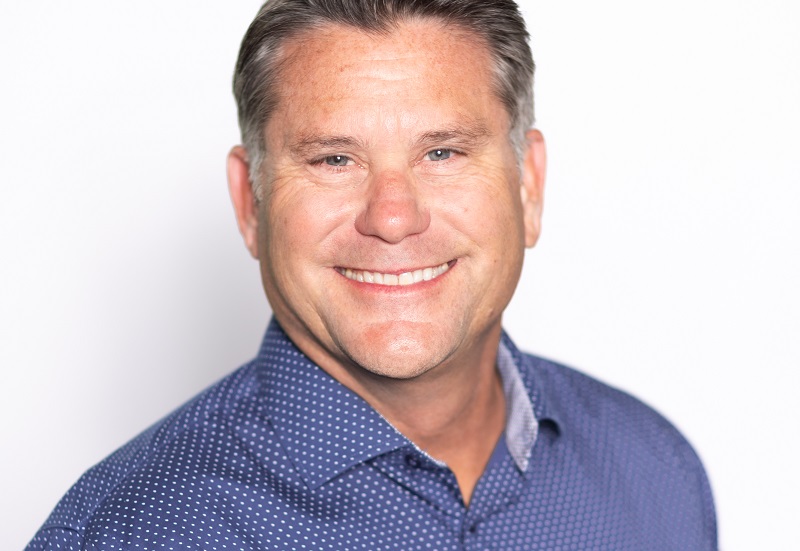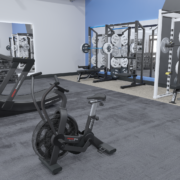CEO Corner: Nautilus’s Jim Barr Believes Future of Fitness Lies in Wake of Three Trends

Nautilus, Inc. CEO and Board Member Jim Barr is the latest interviewee of Athletech News’s CEO Corner series. The dynamic business executive dives deeply into his journey to leading the globally lauded fitness brand, failure, motivation, and what he sees for the future of fitness.
It’s near to impossible to enter a gym or boutique fitness studio without knowing of, hearing of, or seeing a piece of Nautilus, Inc. equipment. The globally recognized brand, founded in 1986, is responsible for introducing leading cardio and strength treadmills, bikes, dumbbells and much more via the Nautilus, Schwinn, Bowflex, and JRNY brand names in 80 countries.
As the fitness industry acclimates to a new, post-pandemic chapter, Nautilus continues to offer state-of-the-art fitness solutions and various innovative ways to exercise, whether indoors or out. Current CEO and Board Member Jim Barr joined the company in July 2019, and since then has maximized his extensive leadership and marketing skills along with consumer growth knowledge to further elevate Nautilus, Inc. The University of Chicago Booth School of Business graduate led famously known brands including OfficeMax, Sears Holdings Corporation, MSN Business Development, and Microsoft in executive roles. After adding two key new talents to Nautilus’ Board of Directors — REI Senior Vice President and Chief Financial Officer Kelley Hall & The Washington Post’s Chief Information Officer and Vice President of Digital Product Development Shailesh Prakash — in 2021, Barr told Athletech News then that the business move had come “at a pivotal time for the company, as it continues its long-term strategic plan.”
Now, one year later, Barr’s plans are seemingly coming into clearer form. The forward-thinking business leader tells Athletech News he believes the future of fitness is wrapped up into three rapidly evolving trends: connected fitness, hybrid fitness and holistic fitness and wellness. With his finger on the pulse of these growing movements, Barr remains focused on making sure Nautilus continues to properly serve its clientele in the post-pandemic era and amid economic unpredictability. Read on to learn more about his vision for Nautilus, Inc. and more in this edition of our CEO Corner series.
Athletech News (ATN): Tell us about your background

Jim Barr: Throughout most of my career, I’ve gravitated toward positions that focus on the intersection of technical innovations and changing customer needs. Thematically, I enjoy finding otherwise good/leading companies that just missed a trend—a change in value proposition, the market, and/or a technological disruption—and helping them recover and thrive through digital growth transformations. I’ve done that in multiple industries, including retail, publishing, ecommerce, heavy equipment auctions, and now fitness. It is tremendously rewarding to see people and companies get back on track and achieve success.
A seminal experience came during the decade I was leading Microsoft’s online businesses beginning at the dawn of the consumer internet. Change was constant— in business models, industry structure and consumer needs. I learned to never become comfortable with the status quo, to keep adapting to change, and thrived in a transformational role that utilized customer insights, technological innovation, and a world-class team to enhance our digital products and services and improve the customer journey.
This passion for reinvigorating growth in companies and brands that are addressing changing value propositions, customer behaviors, and technologic disruptions, led me to roles with Ritchie Bros., OfficeMax, and Sears prior to joining Nautilus.
ATN: Please tell us about Nautilus, Inc. and how your role as CEO came to fruition
Jim Barr: Nautilus, Inc. has an incredibly rich 35-year heritage and is recognized as a leader in home fitness equipment with legacy brands Bowflex and Schwinn Fitness in our portfolio. We are in the most exciting chapter in the company’s history, and I’m extremely fortunate to be part of it.
When I joined Nautilus in 2019, it was clear that the company needed to undergo a digital transformation and we immediately began work on our North Star strategy, which is grounded in consumer insights. It builds on our strengths—well-known brands, a broad portfolio of strength and cardio products at multiple price points, strong omni-channel distribution, and a strong company culture anchored on a noble mission to help people live healthier lives through fitness. It also had to address key weaknesses, such as missing the connected fitness trend, targeting the wrong consumer segments, and dated go-to-market techniques.
Our strategy to transform from an equipment company to one focusing on comprehensive fitness experiences that span equipment, software, and content has enabled us to double our revenue in less than two years and reach an expansive audience – over 325,000 digital members and counting. This work was underway before the pandemic, and we accelerated it to ensure our customers, partners and other key stakeholders could more easily engage with us across all channels. We learned to be agile during the pandemic, which will serve us well post-pandemic and economic uncertainty.
I’ve worked for a lot of companies, but the level of personal commitment and dedication from our employees are like nothing I’ve seen before in my career. Nautilus’ culture centers around collaboration, innovation, transparency, giving and fun, and employees are very passionate about our mission: to empower healthier living through individualized connected fitness experiences.
ATN: What is your greatest accomplishment?
Jim Barr: My family—as a husband and father to our three great kids—two who work in the digital arena, and one in the medical field, and seeing them grow up, thrive and be happy.
Professionally, I have enjoyed each transformation and seeing people develop and succeed by doing things even they did not think were possible. Later, it’s seeing them go on to achieve great things and career satisfaction and talk about how our time together and our team really influenced them and fueled their passions. Those are the moments when I feel the most accomplished. Good leadership impacts many people and is multiplicative.
ATN: When have you failed? Talk about your failures? What have you learned from them?
Jim Barr: My first transformation opportunity with Encyclopaedia Britannica back in the 1990s was more of a failure than a success but it fueled my passion for future roles. We were defining ourselves as a direct-seller of books and thought we were insulated from substitutes, first “lesser” bands of reference materials, then superior electronic substitutes. At first, we fought it, then we came up with online and multimedia versions of Encyclopaedia Britannica, Compton’s Encyclopaedia and Merriam-Webster dictionaries. We had to change the business model as well, since these new electronic versions could not go to market in the same way.
Ultimately, we tried to pivot the company to a transformation around electronically indexing the world’s knowledge, what is now known as a search engine, but that strategy did not take hold in time. While Encyclopaedia Britannica is still around, it’s much smaller and some people view it as one of the first dinosaurs of the internet age.
This experience opened my eyes to the concept that things change fast—a 200-year-old company with the top brand in the industry could be disrupted quickly, and no company is completely safe if it does not evolve based on changing consumer needs. Consumer insights that measure and react to changing habits, and keeping a broad view of substitutes were also key lessons.
Although we did not react quickly enough or as dramatically as we needed to, my passion for transformative situations was fueled.
ATN: What motivates you?
Jim Barr: What motivates me, first and foremost is doing something hard and being successful by taking on challenges many others haven’t. I enjoy being a change agent, thinking strategically, setting the direction and being a positive, persistent, and authentic leader. I like coaching people and inspiring teams. Seeing them be successful is incredibly rewarding. Now that I am closer to the end of my career than the beginning, the idea of leaving a positive legacy for the people and companies I’ve been involved with has become a motivator.
ATN: What did you want to be when you grew up?
Jim Barr: My father was a big influence in my direction. He was an executive in telecommunications and later a CEO in that industry. We had many discussions at the dinner table about business, values, leadership, and people. He never pushed me in a particular direction, but I could see how much of an impact he had on results and people. From a young age, I had a role model in my father and thus knew I wanted to run a business, to be a general manager with P&L responsibility someday.
I structured my early career with that objective in mind. I wanted experiences in many different functions and early opportunities to manage people and projects. I started out as a CPA, which helped me understand financial statements and business drivers. I spent time as a dealmaker and a management consultant while getting my MBA in finance before leading the strategy in my first transformation and then taking a general manager role at Microsoft.
It’s ironic that most of my career has been in ecommerce and digital—things that really did not exist when I was growing up or in college. It’s a good lesson for young people who do not know exactly what they want to do early—don’t stress about that, instead collect experiences and learn critical thinking and problem-solving. Your path will reveal itself.
ATN: Where do you see the future of fitness going?
Jim Barr: It’s been fun to see the fitness industry evolve and grow over the past few years and the future is exciting and the opportunity is robust. I see three key trends:
- Connected fitness is here to stay.
- Fitness has gone hybrid.
- A more holistic view of fitness and wellness is evolving.
Connected fitness is here to stay: The traditional model of working out alone and unconnected resulted in people getting bored with the workout options and not staying consistently on their fitness journey.
Connected fitness brings a variety of ways to work out so you’re less likely to become bored. People are staying with it longer—one day they can simulate running in the Alps, the next they can be coached while watching a streaming service or attending a class. All the while, their progress is recorded, which is also motivating. Thus, while I still see specific modalities continue to become out of favor, connected fitness is here to stay and will continue to evolve. We are in the early innings on how connectivity can create superior fitness experiences.
Fitness has gone hybrid: Fitness habits changed profoundly and for the long-term during the pandemic. It used to be that people chose between gyms and home fitness, but as consumers head back to the gym, home fitness remains more popular than pre-pandemic. More people discovered the convenience of working out at home and how connectedness provided many of the benefits they had at the gym, such as [a] variety of workouts and interaction with others.
The hybrid work model is also a big influence on these fitness habits. While as many as 30% of former gym goers say they will never go back to the gym, many people are building their own home gyms so they can exercise on the days they work from home. Our research shows that about 4 in 10 people worked out at home pre-pandemic and that has held steady for over a year with 7 out of 10 who are working out at home.
A more holistic view of fitness and wellness is evolving: First, our definition of wellness is broadening to include aspects like nutrition and mental well-being. I see these coming together at least digitally to provide a more comprehensive ability to help people live healthier lives. Second, we are focused on consumers’ internal motivations for wellness and supporting their emotional well-being.
Candace Cordelia is a Pennsylvania-based journalist and on-camera broadcaster/host, with a reporting background in wrestling, entertainment, and lifestyle. Her reporting work has been featured on websites and in publications such as Bustle, Pro Wrestling Illustrated, New York Daily News, am New York, ABC News, Yahoo!, Good Morning America, Madame Noire, Sister 2 Sister, etonline.com, Diva Dirt and The Everyday Fan. Her favorite workout influencers include Chloe Ting, Cassey Ho, Pamela Reif and Mary Braun. She still can’t stand burpees and Rebbl Dark Chocolate Immunity Elixir is one of her favorite post-workout protein sips. You can follow Candace on Twitter @CandaceCordelia and on Instagram @thatgirlcandace16.



